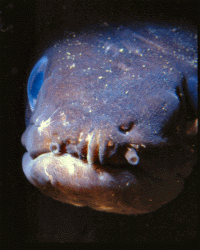| European
Conger Eel Conger
conger
Description
 The largest eel in the world grows up to
5 feet in length and weighs up to 150 pounds,
with specimens up to 9 feet long and weighing 350
pounds known. Its coloring depends on the type of
seabed it inhabits, with the upper body ranging
from almost black in color to a light grayish
brown; the underside is usually silvery in color.
Large gill openings extend to the underside, and
the front pair of nostrils are tubular in shape.
Congers have very strong jaws and extremely sharp
teeth, and the upper jaw extends beyond the
lower. The pectoral fins are large, while the
pelvics are minimal. The dorsal fin runs from
just above the pectorals along the back and end
at the anal fin. The largest eel in the world grows up to
5 feet in length and weighs up to 150 pounds,
with specimens up to 9 feet long and weighing 350
pounds known. Its coloring depends on the type of
seabed it inhabits, with the upper body ranging
from almost black in color to a light grayish
brown; the underside is usually silvery in color.
Large gill openings extend to the underside, and
the front pair of nostrils are tubular in shape.
Congers have very strong jaws and extremely sharp
teeth, and the upper jaw extends beyond the
lower. The pectoral fins are large, while the
pelvics are minimal. The dorsal fin runs from
just above the pectorals along the back and end
at the anal fin.

Distribution and
Habitat
This species lives in the
eastern Atlantic Ocean, from Norway and Iceland
to Senegal, as well as the Mediterranean and
Black seas. They are found in shallow waters by
the shore, down to a depth of over 1,000 feet. It
prefers areas with rough seabed, and typically
inhabits shipwrecks and reefs.
Diet
Congers are strictly
carnivorous and will eat just about anything they
can catch, including bait fish, crabs, cuttlefish
and squid. Those living in shallow waters tend to
be nocturnal feeders, while those living below 60
feet will feed at any time.
Reproduction
Because the conger spawns in
the Sargasso Sea (in the west-central Atlantic)
at depths of 10,000 to 12,000 feet, little is
known about its mating habits. It is believed
that congers only breed once in a lifetime, but
this has not yet been conclusively proven, nor
has the belief that congers die after mating.
Conger lavae bear little
resemblance to adults, being transparent and
flattened. They spend about two years near the
surface before beginning their migration to the
North Atlantic, at which time they become more
cylindrical. They will not develop adult
coloration until they reach a length of 12
inches.
Scientific
Classification
phylum Chordata
subphylum Vertebrata
superclass Osteichthyes
class Actinopterygii
order Anguilliformes
family Congridae
genus & species Conger conger
Questions or comments about
this page?
|



